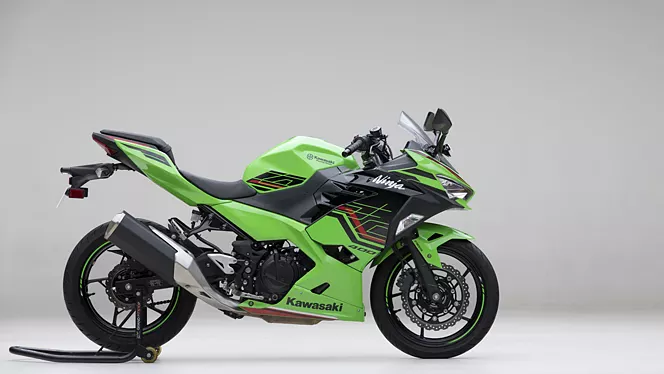Kawasaki Ninja ZX-4R vs Kawasaki Ninja 400

Kawasaki Ninja Zx-4r
Detailed Comparison between Kawasaki Ninja Zx-4r vs Kawasaki Ninja 400

Kawasaki Ninja 400
Both the Ninja 400 and ZX-4R are sporty motorcycles produced by Kawasaki, each offering unique characteristics tailored to different riders and riding styles. Let’s delve into a detailed comparison:

Kawasaki Ninja Zx-4r
1. Engine Performance:
• Ninja 400:
Kawasaki Ninja 400 is powered by 399 cc engine.This Ninja 400 engine generates a power of 45 PS @ 10000 rpm and a torque of 37 Nm @ 8000 rpm.
• ZX-4R:
Powering this diminutive sportbike is a liquid-cooled, 399cc, inline-four engine capable of a peak power output of 77.5hp (which rises to 80hp with RAM air assistance), and it is mated to a 6-speed gearbox. Nestling this inline-four engine is a brand-new steel trellis frame that’s suspended by Showa suspension at either ends, although the specifications vary depending on the variant chosen.

Kawasaki Ninja 400
2. Chassis and Handling:
• Ninja 400:
Known for its nimble handling and lightweight chassis, the Ninja 400 excels in maneuverability, making it ideal for riders seeking agility and ease of control.
• ZX-4R:
With a focus on high-performance riding, the ZX-4R is expected to feature a stiffer frame, advanced suspension components, and aerodynamic enhancements, providing exceptional stability and cornering capabilities on the track.

Kawasaki Ninja Zx-4r
3. Design and Ergonomics:
• Ninja 400:
Designed with a more upright riding position and comfortable ergonomics, the Ninja 400 offers a balance between sporty aesthetics and everyday usability, making it suitable for riders of varying experience levels.
• ZX-4R:
Emphasizing aggressive styling and track-focused ergonomics, the ZX-4R is likely to feature a more aggressive riding posture, with higher footpegs and lower handlebars, optimizing rider positioning for maximum control and aerodynamic efficiency at high speeds.

Kawasaki Ninja 400
4. Technology and Features:
• Ninja 400:
Equipped with modern features such as a digital display, LED lighting, and optional ABS, the Ninja 400 offers essential technology for enhanced convenience and safety.
• ZX-4R:
Expected to feature advanced electronics including traction control, riding modes, quick-shifter, and possibly even semi-active suspension, the ZX-4R is likely to offer a higher level of technological sophistication aimed at enhancing performance and rider confidence on the track.

Kawasaki Ninja Zx-4r
5. Price and Value:
• Ninja 400:
Generally priced lower than its higher-performance counterparts, the Ninja 400 provides excellent value for riders seeking a capable sportbike without breaking the bank.
• ZX-4R:
Positioned as a premium model within Kawasaki’s lineup, the ZX-4R is expected to command a higher price tag due to its advanced engineering, premium components, and track-focused capabilities.
Conclusion:
In summary, while both the Ninja 400 and ZX-4R offer thrilling riding experiences, they cater to different segments of the motorcycle market. The Ninja 400 appeals to riders seeking a versatile and affordable sportbike for everyday use, while the ZX-4R targets enthusiasts craving uncompromising performance and track-ready capabilities. Ultimately, the choice between the two depends on the rider’s priorities, budget, and intended riding environment.



